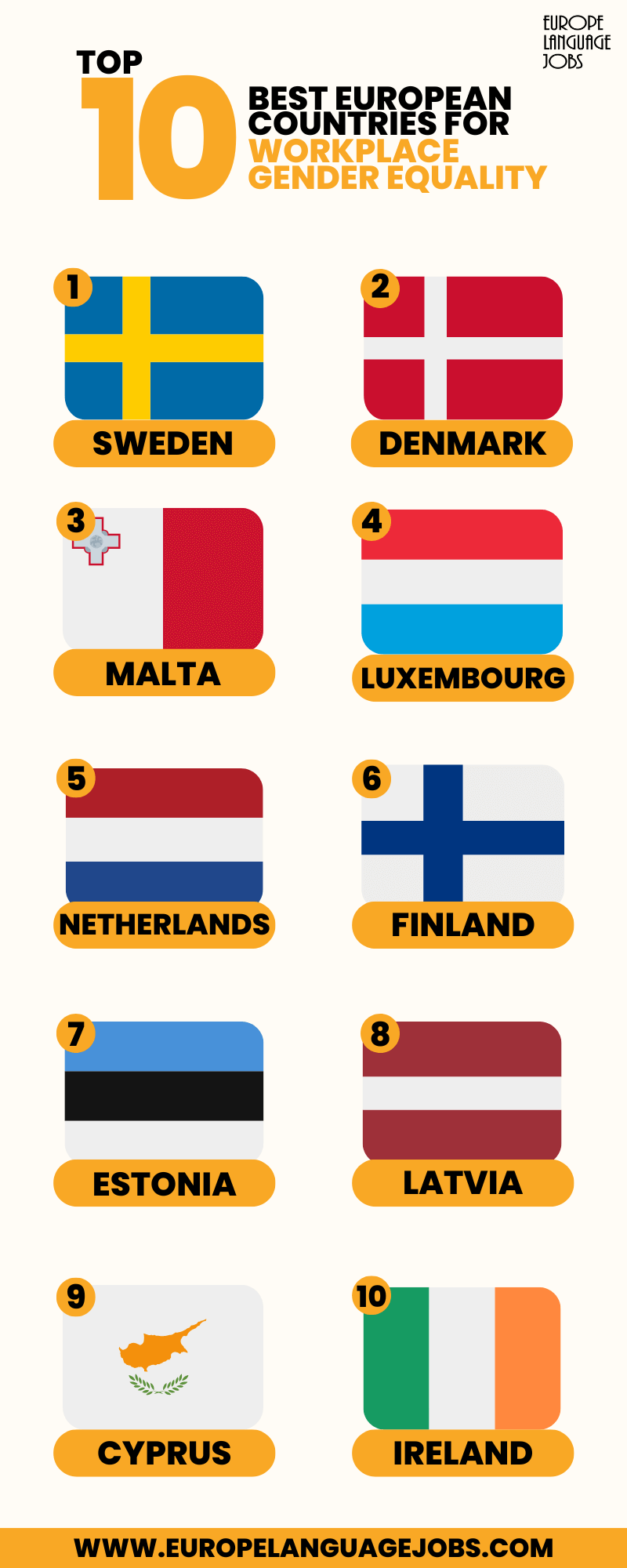International Women’s Day is a time to celebrate the achievements of women all over the world. It is also a time for reflection on the progress the society has made so far in achieving gender equality in various areas of everyday life.
This year, at Europe Language Jobs, we want to focus on workplace equity in Europe. Although a change for the better is happening, some nations have made greater progress in this area than others.
If you are currently deciding where to move abroad for work, perhaps knowing which European countries take the lead in workplace gender equity will help you make your choice.

Gender Equality Index
For the purposes of this article, we used the Gender Equality Index designed by the European Institute for Gender Equality (EIGE) for reference. The index assigns points to each EU member state based on several elements (violence, work, health, power, time, knowledge, and money).
Please note that we are specifically using the Gender Equality Index for the work domain. It assesses countries based on male and female participation in the job market, work segregation, and quality of work. Its score may be different than the one in the general index.
The score for EU as a whole in the domain of work is 74.2.
Disclaimer: The Gender Equality Index only examines EU member states. Norway and Iceland deserve a spot among the top European countries leading in workplace equality for women, but they are not part of the European Union, hence their absence in our ranking.
Top 10 Best European Countries for Workplace Gender Equality

Sweden is Europe’s current leader in the area of workplace equity for women. No wonder, since it is also among the top European countries in regards to the number of female members of the Parliament (45%). With a significant representation, women can count on their needs being addressed at the decision-making level.
Sweden’s parental leave system is referred to as one of the most generous ones in the world, offering each parent 240 days off work. Yes, each parent, as Sweden grants an equal parental leave to both parents, which means that combined, their leave comes up to 480 days.
Additionally, both parents can benefit from the leave at the same time for the first 3 months after the birth or adoption of a child. This equal divide mitigates the risk of one parent missing more working time than the other and halting the career progression of one gender over the other.
Other aspects of gender equality in the workplace are monitored by the Swedish Gender Equality Agency. Established in 2018, it supports government bodies, municipalities, and other organisations in the struggle towards eliminating gender bias and ensuring equal opportunities, in accordance with the legislative objectives.

-
Denmark
Although there is much discussion regarding the state of gender equity in Denmark, it scores second in the Gender Equality Index in the work domain. An attempt at improvement is driven by The Danish Act on Equal Treatment Between Men and Women, which legally regulates issues such as:
-
Working conditions
-
Access to promotion and training
-
Equality in employment and termination
-
Involvement in labour organisations
Additionally, the Consolidation Act on Equal Pay to Men and Women is supposed to close the gender pay gap in Denmark, which as of now, still exceeds the European average (12.7%) at 13.9%.
Still, there is room for improvement, considering how women continue to be largely underrepresented at the C-suite level. Allegedly, there are more men with common Danish names such as Lars or Peter occupying C-suite positions in the 1000 largest companies in Denmark than women (source).
If you believe you have been a witness or victim of gender discrimination in Denmark, you can file a complaint. It will be reviewed and acted upon by the Board of Equal Treatment, a special organ dealing with cases of gender inequality.

-
Malta
Very recently, in 2023, Malta introduced the Gender Equality Plan. It provides an overview of actions taken to ensure gender equality in various areas of everyday life and names legislation which regulates the issue. It also defines examples of discrimination and harassment, and discusses the possible consequences for pursuing them.
Many of the stipulations in the Gender Equality Plan are referenced from the Equality for Men and Women Act signed in 2003. The following of the act is monitored by the Minister for Equality, Research, and Innovation (MFER) and the Human Rights Directorate (HRD). The same organs are also in charge of issues concerning gender identity and sexual orientation - its successes making Malta one of the most tolerant countries in Europe.
Another crucial body is the National Commission for the Promotion of Equality (NCPE). Its mission is to facilitate cooperation between the government and independent organisations. It requests annual reports on the progress achieved in the area of gender equity and raises social awareness, for example by providing training sessions on Gender Mainstreaming in Practice.

-
Luxembourg
Luxembourg is the first country in Europe to have a negative gender pay gap (GPG) score. In the latest statistics from 2022, the rate figures at 0.7%, meaning that on average, women earn 0.7% less than men. For comparison, the second country on the list, Italy, has the rate of 4.3%, while the European average figures at 12.7%.
Still, this doesn’t mean that full gender equality has been achieved in the Luxembourgish workplace. The remaining gap is primarily due to the fact that more women than men undertake part-time jobs.
Another area for improvement lies in the discrepancies between the duration of maternity and paternity leave. While mothers in Luxembourg can count on 20 weeks of leave, fathers only receive up to 10 days. While disappointing and unjust for fathers, this also leaves women at a professional disadvantage, making them the ones who make a more significant sacrifice career-wise than men.
The Ministry of Gender Equality and Diversity, established in 2015, is working on eradicating the remaining issues in the area of gender discrimination. Luxembourg is the only EU member state with a ministry focused entirely on ensuring gender equality.

-
The Netherlands
The Dutch government is steadily working to improve workplace gender equality in many ways. Since 2022, large companies are obliged to share their progress on appointing women in C-suite positions on a dedicated website.
Also in 2022, the Netherlands introduced an equal parental leave for parents working for an employer. Each parent is entitled to 9 weeks of parental leave. This is somewhat of an improvement to the unequal distribution of maternity and paternity leave, with mothers receiving 16 weeks and fathers only 1 week.
An effort is also being made in the social aspect. The Dutch government wants to raise awareness that career choices are often subconsciously influenced by harmful stereotypes concerning genders.
A government-funded campaign called “Becoming Who You Are” (Worden wie je bent) is supposed to challenge stereotypes regarding roles typically associated with men and women. It is created in collaboration with female role models.
Dutch schools are also involved in a government scheme to get more girls interested in pursuing careers in technology and ICT, influencing the mindset from a very young age.

-
Finland
Similarly to Sweden, women in Finland enjoy a considerable representation of female parliament members (45.5%). This increases women’s chances of being heard and acknowledged by fellow women in power.
The Gender Equality Act stipulates that all Finnish employers who regularly employ more than 30 people must create a gender equality plan for the company. It must address issues such as the gender pay gap, job classification, gender segregation, and equal access to opportunities. It is also required to state what is being done to achieve the set goals and how the measures included in the previous plan have worked out.
While the duration of maternity leave in Finland still exceeds that of paternity leave, the length of the latter is much more satisfying than in Luxembourg or the Netherlands, for example. Mothers can count on 105 calendar days, and fathers receive 54 days of paid paternity leave. They may take up to 18 days of paternity leave while the mother is on maternity leave, and the remaining 36 days after the mother has returned to work.
Therefore, while fathers are allowed only half of the leave days of mothers, there is an attempt to facilitate the mother’s return to work while the father takes care of the child. The length of the paternity leave, although still shorter than that of maternity leave, is higher than in many other European countries.

-
Estonia
In 2023, Estonia introduced the new Welfare Development Plan for the years 2023-2030. It sets objectives for multiple areas of everyday life, including gender equality and equal opportunities.
Although women continue to be underrepresented in the Estonian Parliament, the latest elections of 2023 saw the highest number of female members being elected to date. 30 out of 101 Parliament members are currently women.
However, it is worth mentioning that Estonia’s gender pay gap rate is currently the highest in Europe, standing at 21.3%. This means that women earn ⅕ less than men, on average. This statistic remains a stain on the otherwise improving stride towards achieving workplace gender equality in Estonia, and constitutes the subject of intense social debate.

-
Latvia
The gender pay gap rate remains high in Latvia, hovering above the EU average at 17.1%. The employment rate recorded in 2023 was higher for male than female workers, falling at 67.1% and 61.6%, respectively. The greatest disparities can be observed in the age group of 25-34, raising concerns about the lack of progress among the youngest generations in the workforce (source).
Despite the concerning data regarding the employment rate for men and women, there is a conscious effort in Latvia to fight stereotypes resulting from associated specific professions with genders. For example, an analysis from April 2024 demonstrated that women constitute the majority of Latvian police forces. It found that 52% of all employees of the State Police are women.
Social initiatives such as Riga TechGirls aim to educate and provide equal access to resources in order to eradicate the gap between men and women in the technology sector. While there are less female than male workers, the Latvian society strives to close the gap in specific industries commonly perceived as male-dominated.

-
Cyprus
At 10.2%, the GPG rate in Cyprus is below the EU average. The Ministry of Labour, Welfare, and Social Insurance strives to encourage employers to take steps towards achieving gender equality in the workplace by awarding certification called “Gender Equality Employer”. It can be obtained by organisations implementing best practices for achieving gender equality among their employees.
Complaints about gender discrimination in the workplace can be raised to Equality Inspectors, appointed by the Department of Labour. They mediate between employees and employers, ensuring compliance with laws and policies, inspect possible violations, and resolve them.
The issues of maternity, paternity, and parental leave are the subject of discussion. The duration of maternity leave is significantly larger than the paternity leave (18 vs 2 weeks). Some improvements were made in 2022, providing parental leave allowance and aiming to promote work-life balance for parents and carers.

-
Ireland
Ireland boasts one of the lower GPG rates in the EU, at 9.3%. Further effort to close it is being made, thanks to the Gender Pay Gap Information Act introduced in 2021. It requires all employers employing more than 150 people to disclose information regarding hourly GPG disparities across various metrics. In 2025, this legislature will extend to companies with over 50 employees.
The country also implemented the National Strategy for Women and Girls, which ran between 2017 and 2020. It aimed to improve the stride towards gender equality across various sectors, including employment.
A successor to the strategy is being developed - the Irish government undertook a praiseworthy initiative, asking members of the public for their opinions, experiences, and input. They wanted to access a full scope of viewpoints and make sure the strategy addresses issues that the Irish society needs to be addressed. Submissions closed in September 2024, so we can expect that the feedback is currently being assessed and transformed into a new strategy.
Each European country has successes and failures in achieving workplace equality for women. Some offer fair parental leave policies, others focus more on increasing social awareness or legislation targeting employers.
The list of top European countries leading in workplace equality for women is heavily dominated by nations in the Northern part of Europe - 7 out of 10 spots.
But without a doubt, there is still much progress to be made in every country - even in the top 10. It all starts with mentality, so we should do our best to fight for achieving gender equality - in and outside of the workplace - every day, not just on the 8th of March.
Sources:
-
Equality in the Workplace (2023), Irish Citizens Information.
-
The Economic Case for More Gender Equality in Estonia (2022) OECD. Available at: https://www.oecd.org/en/publications/the-economic-case-for-more-gender-equality-in-estonia_299d93b1-en.html (Accessed: 05 March 2025).
-
ETUC Women’s Committee statement on the Finnish government’s working life reforms on gender equality and on women’s position in the labour market (2024). Brussels: ETUC Women’s Committee.
-
Equal opportunities (no date) The Government of the Grand Duchy of Luxembourg.
-
Equal treatment (2024) Tööelu portal.
-
Equality between men and women in the labour market (no date) Workplace Denmark.
-
Equality plans are an important tool for preventing discrimination (2024) PAM.
-
Gender Equality - An incomplete success (no date) Denmark.dk.
-
Gender equality in the work environment (2025) Arbetsmiljöverket.
-
Gender Equality Index 2024: Work (2024) European Institute for Gender Equality.
-
Gender Equality in working life (2024) Ministry of Social Affairs and Health.
-
Guide to maternity leave in Europe (2024) APRIL International.
-
Knight, K. (2024) Gender equality, Estonian Human Rights Centre.
-
Maternity and paternity leave in the EU (2023) European Parliament.
-
Maternity Leave in Europe by Countries: Policies and Benefits (2024) Euro Dev SSC.
-
Improving women’s position in the Dutch labour market (2023), Government of the Netherlands.
-
Monthly Ranking of Women in National Parliaments (no date) IPU Parline.
-
Parents’ leaves in the EU - Infographic (no date) Jacques Delors Institute.
-
Reisch, O., Malécot, C. and Watteau, L. (no date) Impact of directive on transparency and equal pay for men and women in Luxembourg, DLA Piper.
-
Revealed: The Best EU Countries for Workplace Gender Equality (2024) Fair Play Talks.
-
Sweden and Gender Equality (2024) sweden.se.
-
Work & Gender Discrimination (no date) Irish Human Rights and Equality Commission.
-
Working without discrimination (no date) Info Finland.
-
Workplace equality (2024) Job Market Finland.
-
Yanatma, S. (2024) Gender Pay Gap: Only One Country in Europe Pays Women More Than Men, Euronews.






